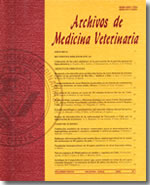Effects of alfalfa haylage harvesting systems on dry matter intake and feeding behaviour of East Friesland ewes in late pregnancy
Main Article Content
Abstract
Three haylages were produced from the same regrowth of an alfalfa sward by cutting the grass using a mower conditioner and wilted for 24 h. The product was divided into three blocks and picked up using the same harvester, but adjusted to produce haylages differing in chop length, i.e. long, unchopped haylage (L); single chopped (S) and double chopped (D) haylage. The haylages were high in dry matter (DM) content (557, 640 and 700 g/kg), with a mean particle length of 250, 70 and 20 mm, for the L, S and D haylages respectively. Twenty four late pregnancy East Friesland ewes were allocated to the 3 treatments. Animals had access to silage throughout the day, with fresh silage being offered daily at 9.00 h. Ewes were allocated to a randomized block design with 8 ewes per treatment and housed in individual pens. All ewes received 0.85 kg/ day of a concentrate supplement. The results of the present study indicate that DM intake was affected by the different alfalfa haylage harvesting systems. Ewes offered L haylage consumed 10.7% and 30.4% less dry matter than those offered S and D haylage, respectively. These differences in total intake were accompanied by marked changes in the eating rate during the first meal, with initial eating rates of ewes offered D haylages being 83.2% and 218% higher than when offered S and L haylage. A better condition score at the end of the experiment was recorded when animals were offered haylage harvested with 12 knives (D treatment) than when offered S or L haylages.

